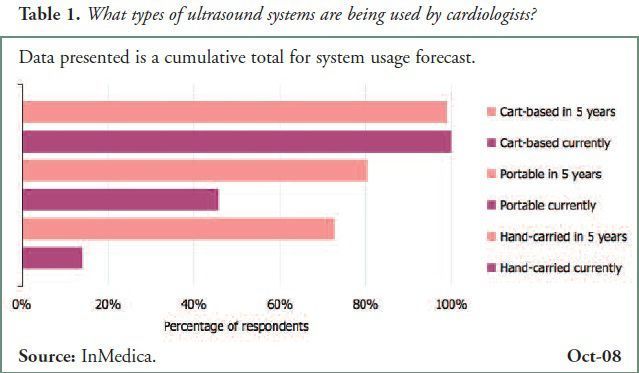HealthManagement, Volume 3 - Issue 1, 2009
Trend Shows Technological Advances Fuelling Growth
The ultrasound imaging equipment market is currently seeing a clear trend towards miniaturisation. The dramatic increase in the use of hand-held and portable ultrasound (defined by In Medical as compact ultrasound), has driven additional growth for ultrasound in markets such as cardiology.
Developments in the ultrasound imaging market today focus on
improvements in diagnostic performance and workflow enhancements. The trend to
portability further aids improvements in point-of care services and ultimately,
patient care. With the ultimate goal of increasing the efficiency and
productivity by which hospitals and clinics operate, these enhancements are
necessary to ensure increased patient volume and throughput, and consequently,
the survival of many hospitals and clinics globally. This holds particular
relevance in the current environment where the cost of healthcare is vastly
outpacing government spending and reimbursement.
Cardiologists Increase Uptake of Portable Ultrasound
The trend to miniaturisation is affecting the use of ultrasound by
cardiologists. A recent survey by In medical on the use of ultrasound in
western European hospitals and imaging centres has highlighted that cardiologists
expect to be using much more mobile ultrasound in the near future, with emerging
applications for ultrasound in cardiology including emergency room, critical
care and bed-side exams.
Cardiologists from across Europe were recruited in this research, to help equipment manufacturers improve their product development and overall service to customers. Working in partnership with a number of leading equipment manufacturers, In Medical designed a questionnaire to gather direct feedback from cardiologists on the equipment they are using, the examinations they are performing, ways in which their systems could be improved and how their work is changing. The results of the survey are presented by In Medical in the report, “European Customer Insights – Ultrasound in Cardiology”.

Survey Results
Table 1 presents the types of ultrasound systems being used by the surveyed cardiologists. While 100% of respondents were using cart-based ultrasound in cardiology, In Medical found that 46% of respondents were also using a portable ultrasound system to complement their traditional cart based system. Furthermore, 73% of respondents expected to be using handheld ultrasound within the next five years.
For future use of hand-carried and portable ultrasound systems in
cardiology, 85% of respondents answered that their role would be complementary
to cart-based systems. Moreover, 6% thought cart-based systems would be fully
replaced by hand-carried and portable systems. Only 9% of respondents thought
that hand-carried systems played no future role for the use of ultrasound in
cardiology.
Workflow Benefits
In relation to workflow, the greatest numbers of responses (25% of cardiologists) were in relation to the positive use of hand. The successful changes reported in the dietary and physical activity results were reflected in the results for risk factor management, i.e. for overweight and obesity, blood pressure, lipids and glucose (see table 2).
Body weight was measured in terms of body mass index, overall weight reduction and weight distribution (central obesity). The initial goal for weight loss in the overweight and obese was 5 - 10% of total body weight.Carried and portable systems in emergency, critically ill and bedside examinations.
21% of respondents considered these systems to have a “strongly
positive” impact in cardiology, relating to the increased use and importance of
hand-carried and portable systems in ad-hoc and routine exams. Conversely
however, 19% of respondents considered that these systems would have little or
no impact on workflow in relation to cardiology. The survey also showed that cardiologists
expect their work to become more mobile in future, with bedside examinations
becoming common practice. Outpatient examinations were also expected to
increase in regularity. By taking ultrasound to the patient, a reduction in
waiting times can be achieved as all scans will not have to be referred to overstretched
imaging departments.
Quality of Care to Rise
Screening and minor scans can also be performed using portable equipment, often by non-imaging specialists, only referring patients to the imaging departments for in-depth scans for serious conditions. The increased use of ultrasound, particularly in new applications, will raise the overall quality of care.






